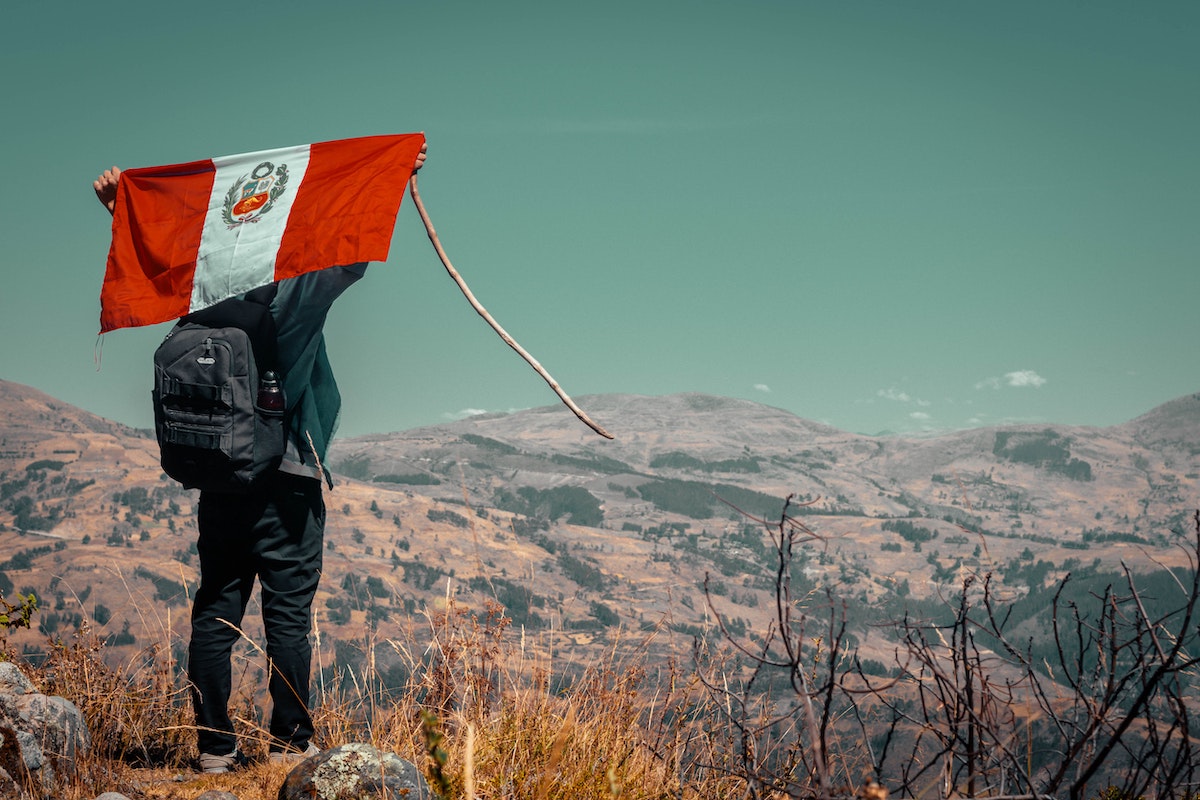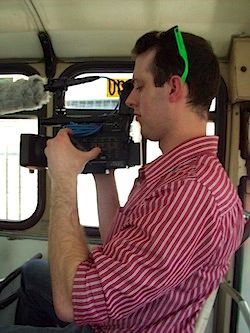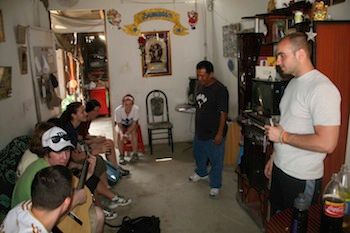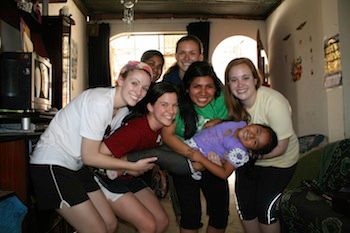
HOPE Was Here: A Study on Voluntourism & Ethics
By: Mark Denega
Skip to Section
“I think Mark is going to cry.”
Lacie Michaelson, a student leader of our Stonehill College alternative spring break group, chided me three months before we left for San Juan de Lurigancho, Peru—the most populous and one of the poorest districts of Lima. I sat cross-legged on the floor surrounded by a circle of desks, eagerly waving my camcorder at 20 students who were unsure why some stranger wanted to film their service trip. It was understandable, then, that few felt compelled to discuss the emotional effects of coming face-to-face with abject poverty for the first time.
I let down the camera. Moments earlier, to ease the tension, I promised the room that if anyone cried on camera, I would remove it from the film upon request. Now, after Lacie’s declaration, it seemed like a good opportunity to further close the divide between them and me.
I turned to Lacie and agreed with her, unequivocally.
“Oh yeah, you’re probably right,” I said. “I’m a crier.”
It was the first day filming my documentary H.O.P.E. Was Here, which follows these students to Peru in an attempt to discover whether trips like theirs are actually a force for good. It’s a debate that still rages as voluntourism continues to boom.
First Timer
At the time, I never volunteered or even really traveled abroad (neither Puerto Rico nor the Canadian side of Niagara Falls count). In my research, though, I read all about “the experience” that people have while working overseas in impoverished places. I read about the culture shock and the newfound appreciation for life, family, and everyday luxuries like running water and a roof to sleep under. All of these things, as I understood, added up to an eye-opening week that transforms people, and sometimes has them watery-eyed before the plane ride home.
While, admittedly I do cry more than most men, I wondered if my statement to Lacie would prove true.
Filming Real Life
Documentary filmmaking is, in part, a guessing game; you prepare as well as you can and hope to be there with the camera rolling when incredible things happen. With just six days to film in Peru, I over-planned my shoots. Using insight from Peace of Me, the memoir by Travis Kumph that inspired the film, I made a blueprint for the trip. I mapped out a narrative trajectory of the week and noted every important moment I could possibly predict. I was ready to make a movie, and felt both confident and empowered.
Ego

That’s me, the big-time filmmaker.
These feelings inflated when the trip began. At the Atlanta airport, when the overhead luggage space filled up before our flight to Lima, other passengers’ belongings were tagged and thrown under the plane, but not my camera equipment. The flight crew wielded my bag through the cabin with purpose, determined to get me and my things where they needed to go.
“We have to make space for this,” said one attendant. “He’s filming their mission!”
That’s right, I thought, I’m an important man doing important work. Please accommodate.
On the bus from the airport to the Peyton Center, the multi-story community center where we stayed, there was more of the same. The students chatted loudly and gazed out the windows, and I sat behind my camera with the same kind of excitement. There I was, young and traveling and getting my big film career off the ground. I was living my dream.
Stick To The Plan
For the next week, I followed the students as they moved between the volunteer sites—a grade school called Fe y Alegria and a rehabilitation center called Yancana Huasy—and then back to the Peyton Center where we retreated to comfortable beds, modern showers, and elaborate meals prepared by the professional cooking staff. Each day brought new adventure and more boxes checked off my shot list.
My pre-planning worked well, and I was satisfied with the footage. I caught some great things on camera, some anticipated and others not. I also spent quality time with the students, who became more than just movie characters, but peers who I admired and respected. For the most part, though, I hid safely behind the camera, using it to guard myself when I didn’t have the courage to speak Spanish to a local or do anything else that seemed too uncomfortable.
Production Winds Down
Our last day was for good-byes. We brought thank you offerings to the staff at Fe y Alegria, Yancana Huasy, and the Peyton Center. Before hitting the road, half of us made one last stop. We visited Jhonny, a happy-go-lucky security guard at the Peyton Center, who was everyone’s favorite new friend. He’d invited us into his two-room house with an aluminum roof, nestled among the overcrowded slums that sprawl across big, dirt mountains around the wealthier, central part of Lima. He wanted us to see and touch the reality of living in poverty, which, as it turns out, is much different than the first-world amenities we enjoyed at Peyton.
Please, Come In

Jhonny speaks to the students inside his house.
When we arrived at the door we caught Jhonny straightening up for us. He’d been sweeping the dusty cement floor and collecting half-deflated balloons scattered about the room, left over from his daughter’s fourth birthday party. He greeted us with great warmth, hugging every person and remembering every name. He asked us to sit, then stood before us and thanked us all from the bottom of his heart. He explained how happy we’d made him and his daughter, Minerva, by coming from the US to spend time with them, albeit briefly. He told us that we were welcome to stay at his home any time.
We Are The World
For the next two hours, we passed around a guitar, sang songs, laughed, and drank Inca Cola. Minerva came home from school, at first terrified to see ten gringos and a camera when she ran through the door. But soon enough she joined in the fun, handing out pieces of her birthday cake and apologizing for its small size, then bouncing from lap to lap to take pictures with all the students.
This was one of those worldly, we-are-all-one experiences that I imagined happened on trips like these. It was truly special, and likely something that is still called “life-affirming” to this day. But just as quickly as it began, it ended.
That’s a Wrap

Jhonny’s daughter, Minerva, stars in the photo shoot.
It was time to go home. Everyone said their farewells at the front door, where more hugs and thank-yous were exchanged. Thinking film-first, I ran across the street to grab one last shot.
Freeze Frame
As I knelt down on the dirt road to get settled, I saw the group starting to trickle off the doorstep and march toward the main intersection. I did some shifting to make sure my composition was just right, then peered into my viewfinder. Through my little digital window I saw Jhonny and Minerva, now alone, standing hand-in-hand in front of their home. They were watching their new friends walk away with a wistful, yet familiar stare. They’d been here before.
My jaw dropped, and I stopped filming. With little time to process thoughts I ran back to Jhonny and thanked him for everything. He refused to say goodbye, only “Hasta luego.”
I ran to catch up with the group.
Leaving Set
Hours later, we piled our backpacks onto the bus and took off for the airport. As we left town, I pointed my camera out the rear windows to get one last look at the place I thought I had come to know, if only a little bit, during our short stay. And as we passed people wandering through the battered dark streets, lit only by the occasional working streetlamp, I remembered Jhonny. Then, I started to weep.
Meltdown
For the first time, I was confronted with the reality of the trip; I was returning to the privilege of my educated, white middle-class American existence after a brush with poverty, which, no doubt, would impress my family and friends over some dinner table conversation.
But Jhonny wasn’t going anywhere, and I would never genuinely know his struggle. What bothered me more was wondering if I’d ever want to. I felt guilt. The $25,000 our group spent on airfare could’ve bought stock rooms of therapy equipment at Yancana Huasy, or paid for more teachers at Fe y Alegria. I felt shame. I came to town, sucked these people’s lives into my camera, and now, I was retreating back home to my editing bay to stamp my name on it and use it to help me make it in the movies. I felt empty. I didn’t know why I’d come here, and I was looking for answers.
I turned around, and there was Lacie, who happened to be sitting at the back of the bus. In that moment, she was the only one I wanted to go heart-to-heart with. I told her exactly how I felt, and she consoled me. She reminded me that I was doing a good thing, but I wondered if the people here really stood to benefit from a documentary film made by a twenty-something American nobody.
Is this it?
I dried my tears, and then, I felt like a cliché. Is this what volunteering abroad was all about—the opportunity for me to feel something outside of my nine-to-five routine? Did I really need to be flown to an underdeveloped community to learn to live with more humility, awareness, and compassion? Part of me thinks that I did, and that made me sad all over again.
Lesson Learned
I cried that day because in my effort to understand the ethics behind volunteering abroad, I became the worst kind of participant. I came only to see what I wanted to see, and took what I needed. I failed to recognize what seems obvious in theory, but harder in practice: there are real people on both ends of these exchanges, and because we are guests, the host communities’ opinions of our presence there matter more than ours.
Another Shot
I’m returning to Peru in two weeks to connect with the people I should have the first time around. I’m returning to ask these Peruvians what they think of American college students dropping in for a week, and how it affects them. I’m returning because I want to find out under what circumstances, if at all, it’s worthwhile for people like me to engage in this kind of travel.
While I’m there, I’ll finish shooting a movie, too.
About the Author
Mark Denega is the filmmaker behind H.O.P.E. Was Here, a volunteer travel documentary in production that explores the merits and pitfalls of short-term volunteering abroad. He is based in Greater New York City. Photos courtesy of the author.
Inline images courtesy of Mark. Featured image via Unsplash.
Information published on this website and across our networks can change over time. Stories and recommendations reflect the subjective opinions of our writers. You should consult multiple sources to ensure you have the most current, safe, and correct details for your own research and plans.
Frayed Passport is a participant in the Amazon Associates Program, an affiliate advertising program designed to provide a means for sites to earn advertising fees by advertising and linking to Amazon.com. We also may share links to other affiliates and sponsors in articles across our website.




